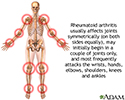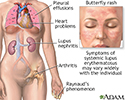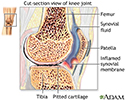Autoimmune disorders
An autoimmune disorder occurs when the body's immune system attacks and destroys healthy body tissue by mistake. There are more than 80 autoimmune disorders.
The body's immune system
The immune response is how your body recognizes and defends itself against bacteria, viruses, and substances that appear foreign and harmful....

Causes
The blood cells in the body's immune system help protect against harmful substances. Examples include bacteria, viruses, toxins, cancer cells, and blood and tissue from outside the body. These substances contain antigens. The immune system produces antibodies against these antigens that enable it to destroy these harmful substances.
Toxins
Toxins are substances created by plants and animals that are poisonous (toxic) to humans. Toxins may also include some medicines that are helpful in...

Cancer
Cancer is the uncontrolled growth of abnormal cells in the body. Cancerous cells are also called malignant cells.
Read Article Now Book Mark ArticleAntibodies
An antibody is a protein produced by the body's immune system when it detects harmful substances, called antigens. Examples of antigens include micr...

When you have an autoimmune disorder, your immune system does not distinguish between healthy tissue and potentially harmful antigens. As a result, your body sets off a reaction that destroys normal tissues.
The exact cause of autoimmune disorders is unknown. One theory is that some microorganisms (such as bacteria or viruses) or drugs may trigger changes that confuse the immune system. This may happen more often in people who have genes that make them more prone to autoimmune disorders.
An autoimmune disorder may result in:
- The destruction of body tissue
- Abnormal growth of an organ
- Changes in organ function
An autoimmune disorder may affect one or more organ or tissue types. Areas often affected by autoimmune disorders include:
- Blood vessels
- Connective tissues
- Endocrine glands such as the thyroid or pancreas
Endocrine
Endocrine glands release (secrete) hormones into the bloodstream. The endocrine glands include:AdrenalHypothalamusIslets of Langerhans in the pancrea...
 ImageRead Article Now Book Mark Article
ImageRead Article Now Book Mark Article - Joints
- Muscles
- Red blood cells
- Skin
A person may have more than one autoimmune disorder at the same time. Common autoimmune disorders include:
- Addison disease
Addison disease
Addison disease is a disorder that causes the adrenal glands to not produce enough hormones.
 ImageRead Article Now Book Mark Article
ImageRead Article Now Book Mark Article - Celiac disease - sprue (gluten-sensitive enteropathy)
Celiac disease - sprue
Celiac disease is an autoimmune condition that damages the lining of the small intestine. This damage comes from a reaction to eating gluten. This ...
 ImageRead Article Now Book Mark Article
ImageRead Article Now Book Mark Article - Dermatomyositis
Dermatomyositis
Dermatomyositis is a disease that involves muscle inflammation and a skin rash. Polymyositis is a similar inflammatory condition that also involves ...
 ImageRead Article Now Book Mark Article
ImageRead Article Now Book Mark Article - Graves disease
Graves disease
Graves disease is an autoimmune disorder that leads to an overactive thyroid gland (hyperthyroidism). An autoimmune disorder is a condition that occ...
 ImageRead Article Now Book Mark Article
ImageRead Article Now Book Mark Article - Hashimoto thyroiditis
Hashimoto thyroiditis
Chronic thyroiditis is caused by a reaction of the immune system against the thyroid gland. It often results in reduced thyroid function (hypothyroi...
 ImageRead Article Now Book Mark Article
ImageRead Article Now Book Mark Article - Inflammatory bowel disease (Crohn disease, ulcerative colitis)
- Multiple sclerosis
Multiple sclerosis
Multiple sclerosis (MS) is an autoimmune disease that affects the brain and spinal cord (central nervous system).
 ImageRead Article Now Book Mark Article
ImageRead Article Now Book Mark Article - Myasthenia gravis
Myasthenia gravis
Myasthenia gravis is a neuromuscular disorder. Neuromuscular disorders involve the muscles and the nerves that control them.
 ImageRead Article Now Book Mark Article
ImageRead Article Now Book Mark Article - Pernicious anemia
Pernicious anemia
Anemia is a condition in which the body does not have enough healthy red blood cells. Red blood cells provide oxygen to body tissues. There are man...
 ImageRead Article Now Book Mark Article
ImageRead Article Now Book Mark Article - Reactive arthritis
Reactive arthritis
Reactive arthritis is a type of arthritis that follows an infection. It may also cause inflammation of the eyes, skin and urinary and genital system...
 ImageRead Article Now Book Mark Article
ImageRead Article Now Book Mark Article - Rheumatoid arthritis
Rheumatoid arthritis
Rheumatoid arthritis (RA) is a disease that leads to inflammation of the joints and surrounding tissues. It is a long-term disease. It can also aff...
 ImageRead Article Now Book Mark Article
ImageRead Article Now Book Mark Article - Sjögren syndrome
Sjögren syndrome
Sjögren syndrome is an autoimmune disorder in which the glands that produce tears and saliva are destroyed. This causes dry mouth and dry eyes. The...
 ImageRead Article Now Book Mark Article
ImageRead Article Now Book Mark Article - Systemic lupus erythematosus (lupus)
Systemic lupus erythematosus
Systemic lupus erythematosus (SLE) is an autoimmune disease. In this disease, the immune system of the body mistakenly attacks healthy tissue. It c...
 ImageRead Article Now Book Mark Article
ImageRead Article Now Book Mark Article - Type I diabetes
Type I diabetes
Type 1 diabetes is a lifelong (chronic) disease in which there is a high level of sugar (glucose) in the blood.
 ImageRead Article Now Book Mark Article
ImageRead Article Now Book Mark Article
Symptoms
Symptoms will vary, based on the type and location of the faulty immune response. Common symptoms include:
- Fatigue
Fatigue
Fatigue is a feeling of weariness, tiredness, or lack of energy.
 ImageRead Article Now Book Mark Article
ImageRead Article Now Book Mark Article - Fever
Fever
Fever is the temporary increase in the body's temperature in response to a disease or illness. A child has a fever when the temperature is at or abov...
 ImageRead Article Now Book Mark Article
ImageRead Article Now Book Mark Article - General ill feeling (malaise)
General ill feeling
Malaise is a general feeling of discomfort, illness, or lack of well-being.
 ImageRead Article Now Book Mark Article
ImageRead Article Now Book Mark Article - Joint pain
- Rash
Rash
Rashes involve changes in the color, feeling or texture of your skin.
 ImageRead Article Now Book Mark Article
ImageRead Article Now Book Mark Article
Exams and Tests
Your health care provider will do a physical exam. Signs depend on the type of disease.
Tests that may be done to diagnose an autoimmune disorder include:
- Antinuclear antibody (ANA) tests
Antinuclear antibody (ANA) tests
The antinuclear antibody panel is a blood test that looks at antinuclear antibodies (ANA). ANA are antibodies produced by the immune system that bind...
 ImageRead Article Now Book Mark Article
ImageRead Article Now Book Mark Article - Autoantibody tests
- Complete blood count (CBC) with white blood cell differential (CBC with WBC differential)
Complete blood count (CBC)
A complete blood count (CBC) test measures the following:The number of white blood cells (WBC count)The number of red blood cells (RBC count)The numb...
 ImageRead Article Now Book Mark Article
ImageRead Article Now Book Mark Article - Comprehensive metabolic panel
Comprehensive metabolic panel
A comprehensive metabolic panel is a group of blood tests. They provide an overall picture of your body's chemical balance and metabolism. Metaboli...
 ImageRead Article Now Book Mark Article
ImageRead Article Now Book Mark Article - C-reactive protein (CRP)
C-reactive protein (CRP)
C-reactive protein (CRP) is produced by the liver. The level of CRP rises when there is inflammation in the body. It is one of a group of proteins,...
 ImageRead Article Now Book Mark Article
ImageRead Article Now Book Mark Article - Erythrocyte sedimentation rate (ESR)
Erythrocyte sedimentation rate (ESR)
ESR stands for erythrocyte sedimentation rate. It is commonly called a "sed rate. "It is a test that indirectly measures the level of certain protei...
 ImageRead Article Now Book Mark Article
ImageRead Article Now Book Mark Article - Urinalysis
Urinalysis
Urinalysis is the physical, chemical, and microscopic examination of urine. It involves a number of tests to detect and measure various compounds th...
 ImageRead Article Now Book Mark Article
ImageRead Article Now Book Mark Article
Treatment
The goals of treatment are to:
- Control the autoimmune process
- Maintain your body's ability to fight disease
- Reduce symptoms
Treatments will depend on your disease and symptoms. Types of treatments include:
- Supplements to replace a substance that the body lacks, such as thyroid hormone, vitamin B12, or insulin, due to the autoimmune disease
- Blood transfusions if blood is affected
- Physical therapy to help with movement if the bones, joints, or muscles are affected
Many people take medicines to reduce the immune system's abnormal response. These are called immunosuppressive medicines. Examples include corticosteroids (such as prednisone) and nonsteroid drugs such as azathioprine, cyclophosphamide, mycophenolate, sirolimus, or tacrolimus. Targeted drugs such as tumor necrosis factor (TNF) blockers and Interleukin inhibitors can be used for some diseases.
Outlook (Prognosis)
The outcome depends on the disease. Most autoimmune diseases are chronic, but many can be controlled with treatment.
Chronic
Chronic refers to something that continues over an extended period of time. A chronic condition is usually long-lasting and does not easily or quick...

Symptoms of autoimmune disorders can come and go. When symptoms get worse, it is called a flare-up.
Possible Complications
Complications depend on the disease. Medicines used to suppress the immune system can cause severe side effects, such as higher risk for infections.
When to Contact a Medical Professional
Contact your provider if you develop symptoms of an autoimmune disorder.
Prevention
There is no known prevention for most autoimmune disorders.
References
Kono DH, Theofilopoulos AN. Autoimmunity and tolerance. In: Firestein GS, Budd RC, Gabriel SE, Koretzky GA, McInnes IB, O'Dell JR, eds. Firestein & Kelley's Textbook of Rheumatology. 11th ed. Philadelphia, PA: Elsevier; 2021:chap 22.
Kumar V, Abbas AK, Aster JC. Diseases of the immune system. In: Kumar V, Abbas AK, Aster JC, eds. Robbins and Cotran Pathologic Basis of Disease. 10th ed. Philadelphia, PA: Elsevier; 2021:chap 6.
Peakman M, Buckland MS. The immunity. In: Feather A, Randall D, Waterhouse M, eds. Kumar and Clarke's Clinical Medicine. 10th ed. Philadelphia, PA: Elsevier; 2021:chap 3.
Graves disease - illustration
Graves disease is an autoimmune disorder that involves overactivity of the thyroid (hyperthyroidism). Hallmarks of the condition are bulging eyes (exophthalmos), heat intolerance, increased energy, difficulty sleeping, diarrhea and anxiety.
Graves disease
illustration
Hashimoto's disease (chronic thyroiditis) - illustration
Chronic thyroiditis (Hashimoto's disease) is a slowly developing persistent inflammation of the thyroid which frequently leads to hypothyroidism, a decreased function of the thyroid gland. Middle-aged women are most commonly affected.
Hashimoto's disease (chronic thyroiditis)
illustration
Multiple sclerosis - illustration
Multiple sclerosis is a central nervous system disorder marked by decreased nerve function with initial inflammation of the protective myelin nerve covering and eventual scarring. Symptoms and severity of symptoms vary widely and may progress into episodes of crisis alternating with episodes of remission.
Multiple sclerosis
illustration
Rheumatoid arthritis - illustration
Rheumatoid arthritis is an autoimmune disease in which the body's immune system attacks itself. The pattern of joints affected is usually symmetrical, involves the hands and other joints and is worse in the morning. Rheumatoid arthritis is also a systemic disease, involving other body organs, whereas osteoarthritis is limited to the joints. Over time, both forms of arthritis can be crippling.
Rheumatoid arthritis
illustration
Rheumatoid arthritis - illustration
Rheumatoid arthritis is a systemic autoimmune disease which initially attacks the synovium, a connective tissue membrane that lines the cavity between joints and secretes a lubricating fluid.
Rheumatoid arthritis
illustration
Systemic lupus erythematosus - illustration
Systemic lupus erythematosus is a chronic inflammatory autoimmune disorder which may affect many organ systems including the skin, joints and internal organs. The disease may be mild or severe and life-threatening. African Americans and Asians are disproportionately affected.
Systemic lupus erythematosus
illustration
Synovial fluid - illustration
The synovial membrane is the inner membrane of tissue that lines a joint. The synovial membrane secretes synovial fluid which serves to lubricate the joint.
Synovial fluid
illustration
Rheumatoid arthritis - illustration
Rheumatoid arthritis is another form of arthritis. The body's own immune system attacks a joint's synovial membrane, which secretes fluid and lines the joint. The synovium becomes inflamed, produces excess fluid, and the cartilage becomes rough and pitted.
Rheumatoid arthritis
illustration
Antibodies - illustration
Antigens are large molecules (usually proteins) on the surface of cells, viruses, fungi, bacteria, and some non-living substances such as toxins, chemicals, drugs, and foreign particles. The immune system recognizes antigens and produces antibodies that destroy substances containing antigens.
Antibodies
illustration
Graves disease - illustration
Graves disease is an autoimmune disorder that involves overactivity of the thyroid (hyperthyroidism). Hallmarks of the condition are bulging eyes (exophthalmos), heat intolerance, increased energy, difficulty sleeping, diarrhea and anxiety.
Graves disease
illustration
Hashimoto's disease (chronic thyroiditis) - illustration
Chronic thyroiditis (Hashimoto's disease) is a slowly developing persistent inflammation of the thyroid which frequently leads to hypothyroidism, a decreased function of the thyroid gland. Middle-aged women are most commonly affected.
Hashimoto's disease (chronic thyroiditis)
illustration
Multiple sclerosis - illustration
Multiple sclerosis is a central nervous system disorder marked by decreased nerve function with initial inflammation of the protective myelin nerve covering and eventual scarring. Symptoms and severity of symptoms vary widely and may progress into episodes of crisis alternating with episodes of remission.
Multiple sclerosis
illustration
Rheumatoid arthritis - illustration
Rheumatoid arthritis is an autoimmune disease in which the body's immune system attacks itself. The pattern of joints affected is usually symmetrical, involves the hands and other joints and is worse in the morning. Rheumatoid arthritis is also a systemic disease, involving other body organs, whereas osteoarthritis is limited to the joints. Over time, both forms of arthritis can be crippling.
Rheumatoid arthritis
illustration
Rheumatoid arthritis - illustration
Rheumatoid arthritis is a systemic autoimmune disease which initially attacks the synovium, a connective tissue membrane that lines the cavity between joints and secretes a lubricating fluid.
Rheumatoid arthritis
illustration
Systemic lupus erythematosus - illustration
Systemic lupus erythematosus is a chronic inflammatory autoimmune disorder which may affect many organ systems including the skin, joints and internal organs. The disease may be mild or severe and life-threatening. African Americans and Asians are disproportionately affected.
Systemic lupus erythematosus
illustration
Synovial fluid - illustration
The synovial membrane is the inner membrane of tissue that lines a joint. The synovial membrane secretes synovial fluid which serves to lubricate the joint.
Synovial fluid
illustration
Rheumatoid arthritis - illustration
Rheumatoid arthritis is another form of arthritis. The body's own immune system attacks a joint's synovial membrane, which secretes fluid and lines the joint. The synovium becomes inflamed, produces excess fluid, and the cartilage becomes rough and pitted.
Rheumatoid arthritis
illustration
Antibodies - illustration
Antigens are large molecules (usually proteins) on the surface of cells, viruses, fungi, bacteria, and some non-living substances such as toxins, chemicals, drugs, and foreign particles. The immune system recognizes antigens and produces antibodies that destroy substances containing antigens.
Antibodies
illustration
Review Date: 6/12/2023
Reviewed By: Jacob Berman, MD, MPH, Clinical Assistant Professor of Medicine, Division of General Internal Medicine, University of Washington School of Medicine, Seattle, WA. Also reviewed by David C. Dugdale, MD, Medical Director, Brenda Conaway, Editorial Director, and the A.D.A.M. Editorial team.











